Chris Loehmer Kincaid's Blog, page 101
February 25, 2018
Lent and Several Rabbit Holes
Last Sunday, when I wrote here what I was going to write about for the next six weeks, I naturally didn’t have a clue what kind of rabbit holes I would go down. I thought I would, on an internet search, find six appropriate songs or hymns which focus on Lent, Good Friday, Easter morning. You get that, right? Shouldn’t be so hard.
For starters, that initial list of songs which I found has already gone out the window. Oh, I shouldn’t say that. They are still here staring at me, but not speaking to me. So, I reverted back to the old Lutheran hymnals I have laying around the house.
Yes, there are two. The first one – The Lutheran Hymnal – is from 1941 and belonged to my mom’s dad’s cousin, I think. The second one – Lutheran Worship - replaced that first one in the Lutheran Church Missouri Synod in 1982. In 2006, we switched to the Lutheran Service Book, and aren’t you glad I don’t have a copy of that sitting around the house. (I really need to downsize!) (Or get on medication for attention deficit.)
Anyway, looking through both those old hymnals, I stumbled across – in the second one – the song below. The words were written by the daughter of a pastor, who went on to also marry a minister. She devoted herself to writing hymns, over 150 of them, many of which were geared towards children.
I could tell you why I like the words, but you should read them for yourself and come up with your own thoughts. Unfortunately, I couldn’t find any YouTube videos which didn’t make me cringe. I guess you will just have to enjoy the words as they are.
O Lord, throughout these forty days you prayed and kept the fast; inspire repentance for our sin, and free us from our past.
You strove with Satan, and you won; your faithfulness endured; lend us your nerve, your skill and trust in God's eternal word.
Though parched and hungry, yet you prayed and fixed your mind above; so teach us to deny ourselves that we may know God's love.
Be with us through this season, Lord, and all our earthly days, that when the final Easter dawns, we join in heaven's praise.
Words by: Claudia Frances Hernaman (1873)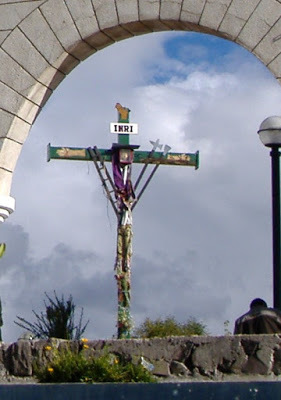 I arrived in Ayacucho, Peru on Easter Sunday in 2009, for a one-week volunteer experience.
I arrived in Ayacucho, Peru on Easter Sunday in 2009, for a one-week volunteer experience.
This cross was on the hill overlooking the city, left behind from Good Friday.
For starters, that initial list of songs which I found has already gone out the window. Oh, I shouldn’t say that. They are still here staring at me, but not speaking to me. So, I reverted back to the old Lutheran hymnals I have laying around the house.
Yes, there are two. The first one – The Lutheran Hymnal – is from 1941 and belonged to my mom’s dad’s cousin, I think. The second one – Lutheran Worship - replaced that first one in the Lutheran Church Missouri Synod in 1982. In 2006, we switched to the Lutheran Service Book, and aren’t you glad I don’t have a copy of that sitting around the house. (I really need to downsize!) (Or get on medication for attention deficit.)
Anyway, looking through both those old hymnals, I stumbled across – in the second one – the song below. The words were written by the daughter of a pastor, who went on to also marry a minister. She devoted herself to writing hymns, over 150 of them, many of which were geared towards children.
I could tell you why I like the words, but you should read them for yourself and come up with your own thoughts. Unfortunately, I couldn’t find any YouTube videos which didn’t make me cringe. I guess you will just have to enjoy the words as they are.
O Lord, throughout these forty days you prayed and kept the fast; inspire repentance for our sin, and free us from our past.
You strove with Satan, and you won; your faithfulness endured; lend us your nerve, your skill and trust in God's eternal word.
Though parched and hungry, yet you prayed and fixed your mind above; so teach us to deny ourselves that we may know God's love.
Be with us through this season, Lord, and all our earthly days, that when the final Easter dawns, we join in heaven's praise.
Words by: Claudia Frances Hernaman (1873)
 I arrived in Ayacucho, Peru on Easter Sunday in 2009, for a one-week volunteer experience.
I arrived in Ayacucho, Peru on Easter Sunday in 2009, for a one-week volunteer experience.This cross was on the hill overlooking the city, left behind from Good Friday.
Published on February 25, 2018 02:35
February 23, 2018
Celebrating Birthdays on Flashback Friday
I’m still slowly working my way through boxes and albums of old photos. I fluctuate between Mom’s and mine, never knowing which set of pictures is going to produce the best gem next.
When I came across this one, I knew I’d stumbled on a rare diamond. I’ve never seen this picture before, don’t know why not. But I love it. It is my sister Pat’s eighth birthday and I am clearly showing my devotion. The girl on the left is our childhood neighbor, Nancy, but I have no clue who the girl on the left is. I’m also not sure where it was taken, certainly not at our house, but possibly at Nancy’s. From the spread of food on the table, there must have been more than the four of us in attendance.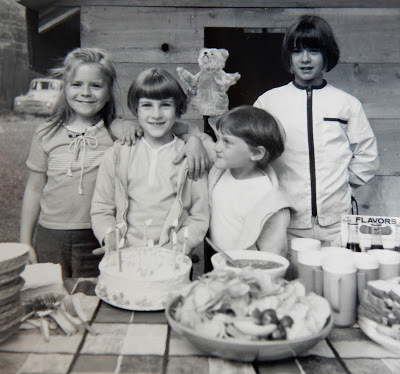
This was of Nancy’s birthday. I know it was taken at her house because that vehicle behind us is the “white van” which was what her mother drove us – and others – to school in. Because there weren’t many kids on our route at the time, this was the actual school bus we rode. It got a little crowded at times. Once, as we were driving down Highway 8, the hood came unlatched and flew off. Scared us all to death. Craziest thing.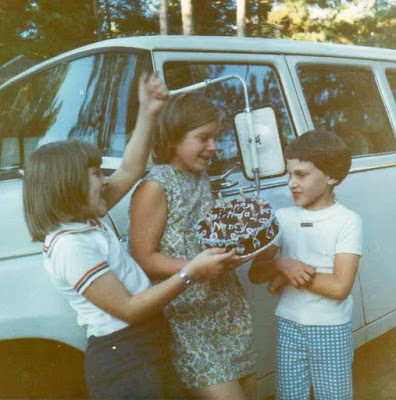
Pat’s birthday in 1971. Apparently, no party that year. So much to see in this photo. The orange Crush soda, the seventies décor kitchen. I should have cropped Mom’s orange backside, but hey, it is what it is.
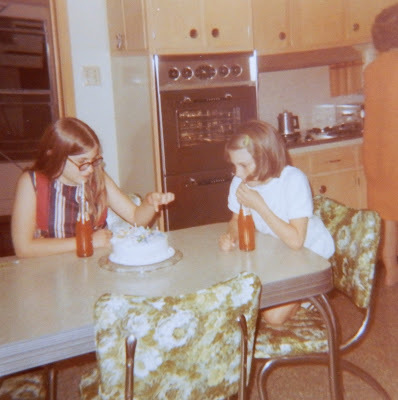 My birthday that same year. That’s Nancy again, on the left, and my cousin Jodean on the right. I had wanted to be a ballerina when I was in kindergarten, but I’m pretty sure that was no longer on my list when I was ten.
My birthday that same year. That’s Nancy again, on the left, and my cousin Jodean on the right. I had wanted to be a ballerina when I was in kindergarten, but I’m pretty sure that was no longer on my list when I was ten.
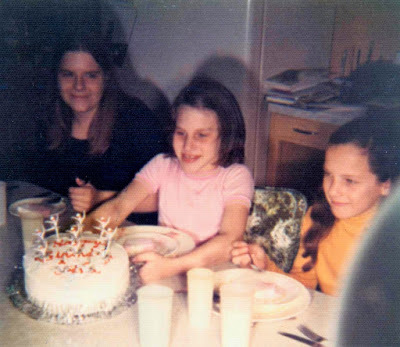 Six years later with my friends from high school. And another spread of food.
Six years later with my friends from high school. And another spread of food.
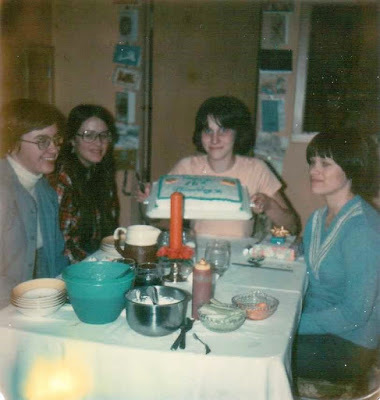
Aren’t these great? Being the bad mom I was, I don’t know if I have this many pictures from my kids’ birthdays. Or they may still be in the bottom of one of these boxes (the pictures, not my kids).
Have a happy day and a happy birthday - whenever it is.
When I came across this one, I knew I’d stumbled on a rare diamond. I’ve never seen this picture before, don’t know why not. But I love it. It is my sister Pat’s eighth birthday and I am clearly showing my devotion. The girl on the left is our childhood neighbor, Nancy, but I have no clue who the girl on the left is. I’m also not sure where it was taken, certainly not at our house, but possibly at Nancy’s. From the spread of food on the table, there must have been more than the four of us in attendance.

This was of Nancy’s birthday. I know it was taken at her house because that vehicle behind us is the “white van” which was what her mother drove us – and others – to school in. Because there weren’t many kids on our route at the time, this was the actual school bus we rode. It got a little crowded at times. Once, as we were driving down Highway 8, the hood came unlatched and flew off. Scared us all to death. Craziest thing.

Pat’s birthday in 1971. Apparently, no party that year. So much to see in this photo. The orange Crush soda, the seventies décor kitchen. I should have cropped Mom’s orange backside, but hey, it is what it is.
 My birthday that same year. That’s Nancy again, on the left, and my cousin Jodean on the right. I had wanted to be a ballerina when I was in kindergarten, but I’m pretty sure that was no longer on my list when I was ten.
My birthday that same year. That’s Nancy again, on the left, and my cousin Jodean on the right. I had wanted to be a ballerina when I was in kindergarten, but I’m pretty sure that was no longer on my list when I was ten.  Six years later with my friends from high school. And another spread of food.
Six years later with my friends from high school. And another spread of food. 
Aren’t these great? Being the bad mom I was, I don’t know if I have this many pictures from my kids’ birthdays. Or they may still be in the bottom of one of these boxes (the pictures, not my kids).
Have a happy day and a happy birthday - whenever it is.
Published on February 23, 2018 04:34
February 21, 2018
Coming to the Clinic - part 1
As some of you know, I have worked in health care for over thirty years. I’ve been in the same position, working as a certified medical assistant with the same doctor in family practice, for the last seventeen years. I love what I do and I love my patients.
But some days – argh – every last one of those patients tests my patience. I wish they had to take a test (and pass it) to be allowed to see their medical professional. If only I could teach a class on how to be the perfect patient.
Hmm? Why not? So here it is, Chris’s Crash Course on Coming to the Clinic. It’s going to be in several installments. I’m not sure how many, coz I am writing this as it comes to me.
So last night, I started writing about all the in’s and out’s of your doctor’s appointments, and it dawned on me that I should back up and give you a run-down on who all the people are who you may encounter.
1) PSR. I don’t know about other clinics, but I think that this is the trend. The first person you meet when you walk in is called the PSR. Stands for patient service representative and used to be called the receptionist. I don’t know why they changed the name, must be something about being politically correct. This person at the front desk does a lot more than “receive” as the term receptionist would imply, so perhaps the name change was warranted. But I still can’t get used to it.
2) PCS. I know, another acronym. This one stands for patient care staff and refers to us people in the back. Most patients call all of us “nurses”, but that is rarely the case. Most clinics that I know of have a few registered nurses (RN) and/or licensed practical nurses (LPN). In general, these professionals went to school to work in hospitals or sometimes nursing homes to deliver direct patient care. The majority of us PCS are medical assistants, either certified or registered, who were trained to work specifically in clinics. A certified MA has gone to school and taken a test offered by the American Association of Medical Assistants, while a registered MA is usually trained on the job and has taken a different test offered by a different certifying board. According to the folks at the AAMA office, these other tests are less intense, but I don’t put a lot of stock in tests or even always in schooling. A person with no formal education can be just as smart and competent as anyone else.
3) Providers. Here again there is a variety of people you may see. When most patients come to the clinic, they say they are going to the doctor, even though they know they may be seeing someone else. Nurse practitioners and physician assistants have at least six to eight years of education and training and are as capable of seeing the majority of patient complaints as a doctor is. Of course, the doctor, who may be an MD (medical doctor) or DO (doctor of osteopathy), has the most education and training and will see the most complicated cases in the office.
4) Then there are all the extra staff you may meet on your visit to the clinic, such as the ones who draw your blood (who may also be medical assistants, but more likely will be a trained phlebotomist or medical tech) or the ones who take your xrays (usually a radiology tech). (There are differences in education and training among all these people as well, but I don’t need to further confuse you.) You might even run into billing specialists, medical records clerks, behavioral health specialists or nurse case managers.
Sounds like it takes a lot of people to run the medical clinic you are about to visit. Just know that we are all doing the best job that we can and that we all want to give you the best care possible.
Join me next week to find out what to expect from your visit.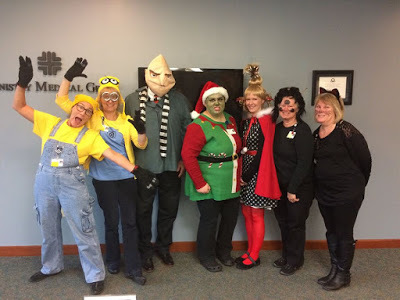 Sometimes our staff is more professional than this.
Sometimes our staff is more professional than this.
But some days – argh – every last one of those patients tests my patience. I wish they had to take a test (and pass it) to be allowed to see their medical professional. If only I could teach a class on how to be the perfect patient.
Hmm? Why not? So here it is, Chris’s Crash Course on Coming to the Clinic. It’s going to be in several installments. I’m not sure how many, coz I am writing this as it comes to me.
So last night, I started writing about all the in’s and out’s of your doctor’s appointments, and it dawned on me that I should back up and give you a run-down on who all the people are who you may encounter.
1) PSR. I don’t know about other clinics, but I think that this is the trend. The first person you meet when you walk in is called the PSR. Stands for patient service representative and used to be called the receptionist. I don’t know why they changed the name, must be something about being politically correct. This person at the front desk does a lot more than “receive” as the term receptionist would imply, so perhaps the name change was warranted. But I still can’t get used to it.
2) PCS. I know, another acronym. This one stands for patient care staff and refers to us people in the back. Most patients call all of us “nurses”, but that is rarely the case. Most clinics that I know of have a few registered nurses (RN) and/or licensed practical nurses (LPN). In general, these professionals went to school to work in hospitals or sometimes nursing homes to deliver direct patient care. The majority of us PCS are medical assistants, either certified or registered, who were trained to work specifically in clinics. A certified MA has gone to school and taken a test offered by the American Association of Medical Assistants, while a registered MA is usually trained on the job and has taken a different test offered by a different certifying board. According to the folks at the AAMA office, these other tests are less intense, but I don’t put a lot of stock in tests or even always in schooling. A person with no formal education can be just as smart and competent as anyone else.
3) Providers. Here again there is a variety of people you may see. When most patients come to the clinic, they say they are going to the doctor, even though they know they may be seeing someone else. Nurse practitioners and physician assistants have at least six to eight years of education and training and are as capable of seeing the majority of patient complaints as a doctor is. Of course, the doctor, who may be an MD (medical doctor) or DO (doctor of osteopathy), has the most education and training and will see the most complicated cases in the office.
4) Then there are all the extra staff you may meet on your visit to the clinic, such as the ones who draw your blood (who may also be medical assistants, but more likely will be a trained phlebotomist or medical tech) or the ones who take your xrays (usually a radiology tech). (There are differences in education and training among all these people as well, but I don’t need to further confuse you.) You might even run into billing specialists, medical records clerks, behavioral health specialists or nurse case managers.
Sounds like it takes a lot of people to run the medical clinic you are about to visit. Just know that we are all doing the best job that we can and that we all want to give you the best care possible.
Join me next week to find out what to expect from your visit.
 Sometimes our staff is more professional than this.
Sometimes our staff is more professional than this.
Published on February 21, 2018 10:32
February 18, 2018
Where I'll Stand
If you follow this blog on a regular basis, you know that for the month of December, I wrote three times a week about various Christmas traditions. I usually write about some such theme throughout December and I have tried, in the past, to come up with a theme for Lent - the six weeks prior to Easter - as well. Not quite such an easy task. The secular world hasn’t embraced Lent like it has Christmas, but I believe that is a good thing. It is said that Christmas Eve is the holiest night of the year, but isn’t all of this season, from Ash Wednesday to Good Friday to Easter morning, if not the holiest, certainly the most sacred.
When I did a Google search of Easter or Lenten traditions, I came up with next to nothing. Nothing anyway that I could write about for six weeks. I decided to narrow my search to hymns, since I’ve always loved singing all the hymns we sang in church when I was a kid (I was always totally off key, the way). I checked the hymnal at church. All of the Lenten songs are rather depressing. Yes, we should be somber and solemn when we think about this six weeks culminating in Jesus’ death on the cross. But I just can’t do that.
My Google search of Easter hymns finally showed some results I could live with. I found a variety of songs, from old to new, and will share one each Sunday through Easter morning.
This first song was just written in 2001 by Stuart Townend and Keith Getty. It has been done by a variety of performers. I hope you look for some of those videos on YouTube.
“In Christ alone, my hope is found;He is my light, my strength, my song;This cornerstone, this solid ground,Firm through the fiercest drought and storm.What heights of love, what depths of peace,When fears are stilled, when strivings cease!My comforter, my all in all—Here in the love of Christ I stand.
“In Christ alone, Who took on flesh,Fullness of God in helpless babe!This gift of love and righteousness,Scorned by the ones He came to save.Till on that cross as Jesus died,The wrath of God was satisfied;For ev’ry sin on Him was laid—Here in the death of Christ I live.
“There in the ground His body lay,Light of the world by darkness slain;Then bursting forth in glorious day,Up from the grave He rose again!And as He stands in victory,Sin’s curse has lost its grip on me;For I am His and He is mine—Bought with the precious blood of Christ.
“No guilt in life, no fear in death—This is the pow’r of Christ in me;From life’s first cry to final breath,Jesus commands my destiny.No pow’r of hell, no scheme of man,Can ever pluck me from His hand;Till He returns or calls me home—Here in the pow’r of Christ I’ll stand.”
— Stuart Townend & Keith GettyCopyright © 2001 Thankyou Music (Adm. by CapitolCMGPublishing.com excl. UK & Europe, adm. by Integrity Music, part of the David C Cook family, songs@integritymusic.com)
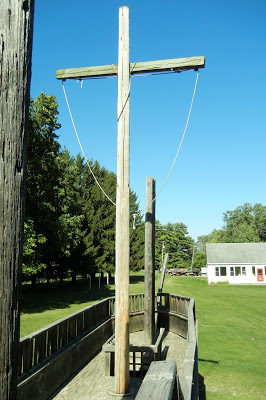 I'm also going through my pictures to share a different cross each Sunday.
I'm also going through my pictures to share a different cross each Sunday. This one is on the children's ship on the grounds of the Green Lake Conference Center, taken in 2011.
Published on February 18, 2018 04:27
February 16, 2018
A Few Days Into Lent
As I mentioned here a few years ago, when I was a kid most of my friends were Catholic and were obligated to give something up for Lent. It seemed that was all they talked about for those six weeks before Easter. These days, I don’t hear anyone mention it, but surely someone out there, devote Catholic or not, does something every day throughout Lent to remind themselves of the suffering that Jesus endured for us. I hope so at least.
I’ve been thinking about it for a while – what should I give up this year? Something challenging like chocolate (which I have done multiple times)? Something easier like snacking between meals? Something less tangible like thinking badly of others?
A few years ago, an acquaintance sent me a card a few weeks before Easter saying that she was spending the forty days sending a card each day to someone she respected or admired or who just might need a thinking of you card. That sounded like a neat idea, then as now. Then the other day, someone on Facebook asked what people do to grow closer to Jesus during Lent. One of the responses was to literally give something up each day, find something around the house each day that you no longer use or need and throw it out or donate it to charity. Simplify your living space. Or even better, simply simplify your life.
I’ve taken all of those thoughts into consideration and here is what I’ve decided to do in honor of Lent this year.
First, because it would be time-consuming and mind-numbing to go around the house each day choosing one thing to discard, I will instead gather an entire box or bag full of junk once a week to take to Goodwill or St Vincent’s. Or unfortunately throw out because I actually do have a lot of junk around here.
Two years ago I made a list of all the people from my past who I have lost touch with and started trying to track them down. I found the obituary of one of them and another one died suddenly before I got around to sending him a note. I did send a letter to one person from college who I found on-line and he even wrote me back. But there are still ten names on that list and I’m going to try to track down every one of them before Easter and send them each a letter.
In addition, I’m giving up Facebook. I know, what? Looking at the statistics for this blog, I realize that most of you come here from the link I post on Facebook. I post it to other social media as well, but not nearly as many of you come here from those sites. It’s all Facebook for my followers. So, yes, I will still post my blogs for all of you to find and follow. And I will open my personal Facebook page when I am on-line but only to see if anyone is commenting on those few links or mentioning me by name on some other post. I can’t afford to be a total hermit, but I need to stop letting social media suck the life right out of me.
I don’t know. I know that back in the day, when my Catholic friends were told they had to choose something to give up eating or doing from Ash Wednesday until Easter morning, the premise was to suffer like Jesus for those six weeks. But I don’t think it should be about suffering as much as about realizing what matters in this life and what doesn’t. All those posts and random thoughts that everyone puts on Facebook as well as all the clothes in my closet and junk sitting around my house really don’t amount too much, not as much as old college roommates and former co-workers.
What else is important? Spending time with family and friends – in person, not on-line. Enjoying your favorite clothes that you wear all the time instead of those dresses you wear once a year. Owning possessions which have a story to tell instead of being things which take up space on a wall or a floor. Finding peace in the little things. Living a simple life. Practicing all that for the six weeks of Lent, and then holding onto it for the rest of the year.
I’ve been thinking about it for a while – what should I give up this year? Something challenging like chocolate (which I have done multiple times)? Something easier like snacking between meals? Something less tangible like thinking badly of others?
A few years ago, an acquaintance sent me a card a few weeks before Easter saying that she was spending the forty days sending a card each day to someone she respected or admired or who just might need a thinking of you card. That sounded like a neat idea, then as now. Then the other day, someone on Facebook asked what people do to grow closer to Jesus during Lent. One of the responses was to literally give something up each day, find something around the house each day that you no longer use or need and throw it out or donate it to charity. Simplify your living space. Or even better, simply simplify your life.
I’ve taken all of those thoughts into consideration and here is what I’ve decided to do in honor of Lent this year.
First, because it would be time-consuming and mind-numbing to go around the house each day choosing one thing to discard, I will instead gather an entire box or bag full of junk once a week to take to Goodwill or St Vincent’s. Or unfortunately throw out because I actually do have a lot of junk around here.
Two years ago I made a list of all the people from my past who I have lost touch with and started trying to track them down. I found the obituary of one of them and another one died suddenly before I got around to sending him a note. I did send a letter to one person from college who I found on-line and he even wrote me back. But there are still ten names on that list and I’m going to try to track down every one of them before Easter and send them each a letter.
In addition, I’m giving up Facebook. I know, what? Looking at the statistics for this blog, I realize that most of you come here from the link I post on Facebook. I post it to other social media as well, but not nearly as many of you come here from those sites. It’s all Facebook for my followers. So, yes, I will still post my blogs for all of you to find and follow. And I will open my personal Facebook page when I am on-line but only to see if anyone is commenting on those few links or mentioning me by name on some other post. I can’t afford to be a total hermit, but I need to stop letting social media suck the life right out of me.
I don’t know. I know that back in the day, when my Catholic friends were told they had to choose something to give up eating or doing from Ash Wednesday until Easter morning, the premise was to suffer like Jesus for those six weeks. But I don’t think it should be about suffering as much as about realizing what matters in this life and what doesn’t. All those posts and random thoughts that everyone puts on Facebook as well as all the clothes in my closet and junk sitting around my house really don’t amount too much, not as much as old college roommates and former co-workers.
What else is important? Spending time with family and friends – in person, not on-line. Enjoying your favorite clothes that you wear all the time instead of those dresses you wear once a year. Owning possessions which have a story to tell instead of being things which take up space on a wall or a floor. Finding peace in the little things. Living a simple life. Practicing all that for the six weeks of Lent, and then holding onto it for the rest of the year.

Published on February 16, 2018 04:01
February 14, 2018
The Value of Words
Here it is Valentine’s Day as well as Ash Wednesday. You would think that I could find something about this day to write a blog post about. Yet, here I sit at my laptop sensing a ramble coming on.
I usually write my blog posts the night before and then post them first thing the next morning. Last night, even though I got home from work a little after six and had nothing special I had to do the rest of the evening, I never got around to writing anything. After watching “Hawaii 5-O” with the hubby, while eating supper, I headed to my office and spent the next few hours wasting time on the computer, talking to a few people on line and looking at old family photos. I do not know where some evenings go.
I’ve been awake since four a.m. and finally got up at five, because my head was still spinning trying to figure out what to write. For the last four or five years (maybe more), my goal has been to blog on Wednesdays, Fridays and Sundays. It seems, that most weeks, those days work the best for me. I’ve altered that schedule at times, but always fall back on that. Some days, when I really am at a loss for ideas, I skip posting altogether, as I probably should be doing today. I know, after all the reading I’ve done on writing, that even though one should always keep writing, sometimes it’s better to keep it to yourself than share it with others, such as when you have nothing to say.
Yet, here I am, about to share this bunch of random fodder with you, because I guess I wanted to give you a peak into my world, into what’s in my head at five a.m. when I can’t sleep.
To go along with it, here is an equally random photo, taken of me and my cat in my parent’s front yard, circa 1969. Being oh so creative even then, already valuing the use of words.
Happy Valentine’s Day and welcome to Lent.
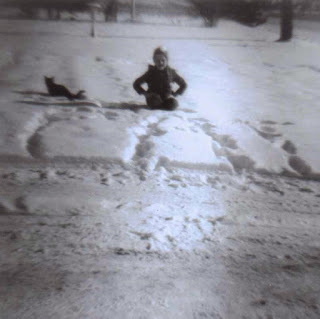
Published on February 14, 2018 03:46
February 11, 2018
Passing Through Rough Waters

But now, this is what the Lord says — “Do not fear, for I have redeemed you; I have summoned you by name; you are mine. When you pass through the waters, I will be with you;and when you pass through the rivers, they will not sweep over you.When you walk through the fire, you will not be burned; the flames will not set you ablaze. (Isaiah 43:1-2 New International Version)
It’s been suggested, when a person is feeling down, that they look for the good in every situation, or better yet that they look for something to feel grateful for in every situation. To write down, every day, at least one thing you are thankful for. And of course, every day, I can think of dozens of things that I am thankful for.
Except for the days when I feel cracked and broken, useless and ignored, defeated and unloved. And don’t tell me that you haven’t had days like that too, coz I know you have. So, what’s a person to do on days like that?
I decided that instead of writing down all the cheesy things I’m grateful for, that I would start a journal of the worst things that happen to me every day.
I know what you’re gonna say. “What is wrong with you, Chris? Don’t be so negative. Looking at the bad stuff is only going to drag you down more. You have to remember all the good things that happen each day and don’t dwell on the bad.”
That’s what you would think. But try it.
The first night, when I started that journal last week, and I wrote down “#1 one of my patients was admitted to hospice”, it dawned on me. Maybe that’s not the worst thing. He is a sweet man who has had a hard life, maybe knowing his battle is almost finished, that he will soon be falling into the loving arm’s of Jesus isn’t such a bad thing.
Then I wrote down “#2 my Achilles tendon continues to ache, sometimes more, sometimes less, but I’m getting tired of it”. I actually brought this up to a patient that day when we were talking about aches and pains, and we both realized that having aches and pains in a heel or a wrist or a back means that you still have those body parts and can still feel them. You haven’t had something amputated and you’re not paralyzed. (The truly neat thing about that conversation was that at the end of it, this patient said, “you must be a Christian”.)
I arrived at yesterday, and added another thing to my growing list. “The boyfriend of a good friend died last night.” And I got nothing, nothing good to say about that, no hidden treasure, no secret lining. Nothing. And some days are like that but at the end of those days, I still know I am a child of God and He is always with me.
Thank You, Lord God, for always, always being with me. Amen.
Published on February 11, 2018 03:48
February 9, 2018
Flashback Friday - one year ago and many years before
I was going through all the old family photos, trying to decide which ones to post and around what theme. I’ve come across a lot of pictures of my mom, what a beautiful woman she was, a dedicated mom, wife and sister. A year ago today, they discharged her from the nursing home and we took her back to her apartment, where I stayed with her round the clock (with lots of help from my brother and sister) through the weekend. Two days after being home she realized that she just couldn’t make it on her own anymore and two days after that we admitted her back to the nursing home. Another two days later she was admitted to the hospital where she died within hours. Weird how that all came down. Seems so long ago already.
As everyone in the family knows, she hated having her picture taken. I mean, it is legendary how much she despised it. I’m surprised I found all the good pictures of her that I did. I guess she wasn’t always photo-phobic.
Sorry, Mom, to post these all. (The only picture from her past that she told me she really hated was her senior portrait, so at least I will honor her by not sharing that one.)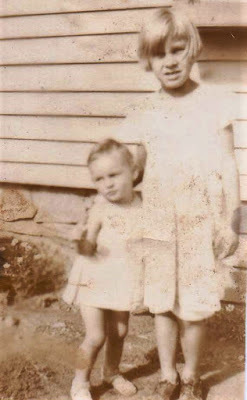 1929 with her sister Helen
1929 with her sister Helen
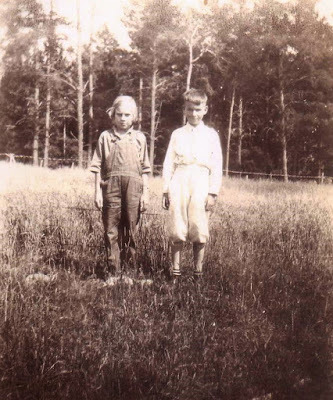 1935, the back of the picture reads "me with Billy S from Milwaukee"
1935, the back of the picture reads "me with Billy S from Milwaukee"
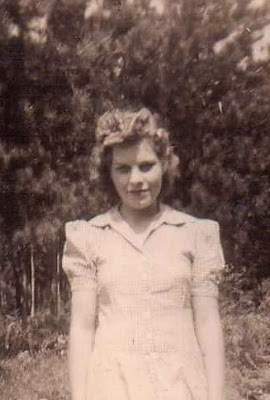 1940s, when she was still in high school
1940s, when she was still in high school
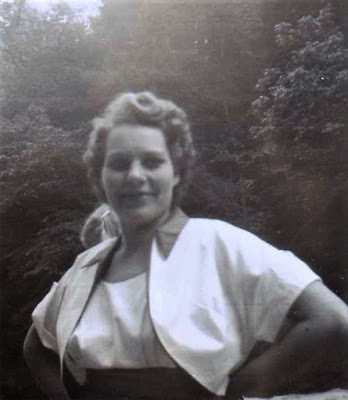 not sure when or where
not sure when or where
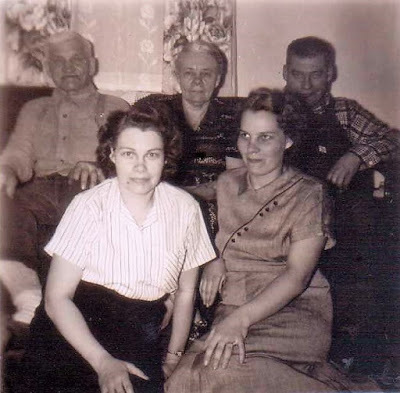
1946 with her Pa, Ma, Brother Robert and Sister Helen (Mom's on the right)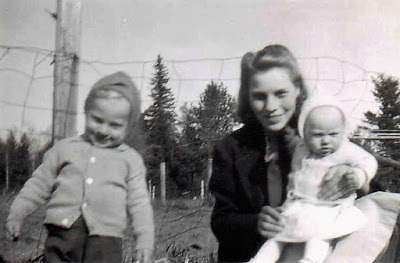 1948 with my brother Tom and sister Judy
1948 with my brother Tom and sister Judy
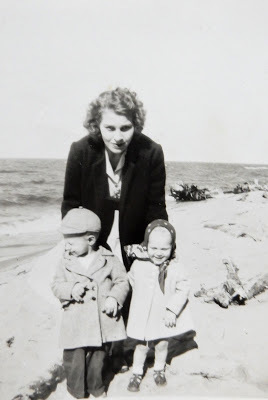 1949 with Tom and Judy
1949 with Tom and Judy
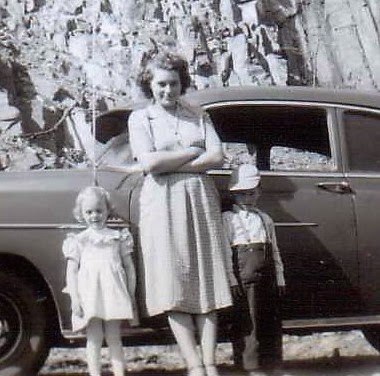 1952 with Judy and Tom again
1952 with Judy and Tom again
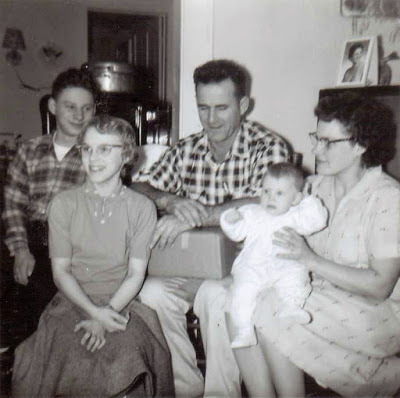 1959 with Tom, Judy, Dad and baby sister Pat
1959 with Tom, Judy, Dad and baby sister Pat
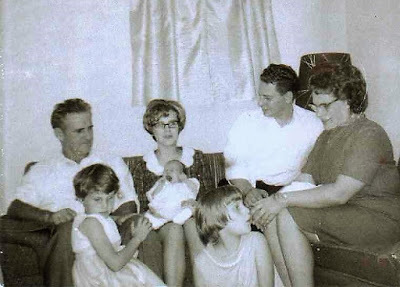 1968, finally a family picture of me (on the lower left), my sister Pat on the lower right, then Dad, Judy with her baby Paula, Tom and Mom
1968, finally a family picture of me (on the lower left), my sister Pat on the lower right, then Dad, Judy with her baby Paula, Tom and Mom
As everyone in the family knows, she hated having her picture taken. I mean, it is legendary how much she despised it. I’m surprised I found all the good pictures of her that I did. I guess she wasn’t always photo-phobic.
Sorry, Mom, to post these all. (The only picture from her past that she told me she really hated was her senior portrait, so at least I will honor her by not sharing that one.)
 1929 with her sister Helen
1929 with her sister Helen
 1935, the back of the picture reads "me with Billy S from Milwaukee"
1935, the back of the picture reads "me with Billy S from Milwaukee"
 1940s, when she was still in high school
1940s, when she was still in high school
 not sure when or where
not sure when or where

1946 with her Pa, Ma, Brother Robert and Sister Helen (Mom's on the right)
 1948 with my brother Tom and sister Judy
1948 with my brother Tom and sister Judy
 1949 with Tom and Judy
1949 with Tom and Judy
 1952 with Judy and Tom again
1952 with Judy and Tom again
 1959 with Tom, Judy, Dad and baby sister Pat
1959 with Tom, Judy, Dad and baby sister Pat
 1968, finally a family picture of me (on the lower left), my sister Pat on the lower right, then Dad, Judy with her baby Paula, Tom and Mom
1968, finally a family picture of me (on the lower left), my sister Pat on the lower right, then Dad, Judy with her baby Paula, Tom and Mom
Published on February 09, 2018 03:14
February 7, 2018
What Safari Camp Would You Stay At?
It’s been quite a while since I’ve shared an excerpt from “Where the Sky Meets the Sand”. I’ve been trying to find pictures from my own travels to Kenya which would fit one of the scenes. Since I have the whole story already pictured in my head, sometimes it’s harder than one would think for me to find the right actual photo out of the thousands I’ve taken.
The camp was so small—three large tents, two small ones, a cement block outhouse, and a cement block storage building—that it took only a few minutes for a tour. Jenny found their large tent comfortable, though rustic. A full-size bed took up the majority of the room. Nightstands flanked each side of the bed and each stand held a small battery-operated lantern. Across from the bed stood a small dresser on which a pitcher of clear water, a large basin, and two sealed bottles of drinking water waited invitingly. She poured a small amount of water into the basin and splashed it on her face. The hand towel hanging from a bar on the side of the dresser was soft and smelled of fresh air. “Think you can handle this for a few days?” Paul asked, trying out the bed. “No running water, no hot shower?” “It will be fine. It will be an adventure.” The crazy thing is that I wrote this scene sometime between my first and second safaris. The first time I went in 2006, we stayed at a luxury camp with running water, electricity and all the amenities of a five-star American resort. It was nothing like the camp where I imagine Jenny and Paul staying. After writing their story about Africa, I went on my second safari in 2015, and we stayed at Manyatta Camp, where these pictures were taken. I felt much more at home there, but it still wasn’t as rustic as what Jenny and Paul experienced. My dream would be to actually camp out on the African plain. Maybe next time I’m there!
The crazy thing is that I wrote this scene sometime between my first and second safaris. The first time I went in 2006, we stayed at a luxury camp with running water, electricity and all the amenities of a five-star American resort. It was nothing like the camp where I imagine Jenny and Paul staying. After writing their story about Africa, I went on my second safari in 2015, and we stayed at Manyatta Camp, where these pictures were taken. I felt much more at home there, but it still wasn’t as rustic as what Jenny and Paul experienced. My dream would be to actually camp out on the African plain. Maybe next time I’m there!
 Let me know if you want to take a life-changing trip to Kenya. In addition to going on safari, you will have the chance to change the lives of those living in poverty. This coming weekend we will begin planning this year’s trips with Tumaini Volunteers. You don’t want to be left behind!
Let me know if you want to take a life-changing trip to Kenya. In addition to going on safari, you will have the chance to change the lives of those living in poverty. This coming weekend we will begin planning this year’s trips with Tumaini Volunteers. You don’t want to be left behind!
(But if a trip to Africa is just not on your bucket-list, you can still read about the adventures Jenny and Paul have while they are there. Click here to get a copy of their story.)
The camp was so small—three large tents, two small ones, a cement block outhouse, and a cement block storage building—that it took only a few minutes for a tour. Jenny found their large tent comfortable, though rustic. A full-size bed took up the majority of the room. Nightstands flanked each side of the bed and each stand held a small battery-operated lantern. Across from the bed stood a small dresser on which a pitcher of clear water, a large basin, and two sealed bottles of drinking water waited invitingly. She poured a small amount of water into the basin and splashed it on her face. The hand towel hanging from a bar on the side of the dresser was soft and smelled of fresh air. “Think you can handle this for a few days?” Paul asked, trying out the bed. “No running water, no hot shower?” “It will be fine. It will be an adventure.”
 The crazy thing is that I wrote this scene sometime between my first and second safaris. The first time I went in 2006, we stayed at a luxury camp with running water, electricity and all the amenities of a five-star American resort. It was nothing like the camp where I imagine Jenny and Paul staying. After writing their story about Africa, I went on my second safari in 2015, and we stayed at Manyatta Camp, where these pictures were taken. I felt much more at home there, but it still wasn’t as rustic as what Jenny and Paul experienced. My dream would be to actually camp out on the African plain. Maybe next time I’m there!
The crazy thing is that I wrote this scene sometime between my first and second safaris. The first time I went in 2006, we stayed at a luxury camp with running water, electricity and all the amenities of a five-star American resort. It was nothing like the camp where I imagine Jenny and Paul staying. After writing their story about Africa, I went on my second safari in 2015, and we stayed at Manyatta Camp, where these pictures were taken. I felt much more at home there, but it still wasn’t as rustic as what Jenny and Paul experienced. My dream would be to actually camp out on the African plain. Maybe next time I’m there!  Let me know if you want to take a life-changing trip to Kenya. In addition to going on safari, you will have the chance to change the lives of those living in poverty. This coming weekend we will begin planning this year’s trips with Tumaini Volunteers. You don’t want to be left behind!
Let me know if you want to take a life-changing trip to Kenya. In addition to going on safari, you will have the chance to change the lives of those living in poverty. This coming weekend we will begin planning this year’s trips with Tumaini Volunteers. You don’t want to be left behind!(But if a trip to Africa is just not on your bucket-list, you can still read about the adventures Jenny and Paul have while they are there. Click here to get a copy of their story.)

Published on February 07, 2018 03:45
February 4, 2018
Where God's Plans Are
“For I know the plans I have for you,” declares the Lord, “plans to prosper you and not to harm you, plans to give you hope and a future.” (Jeremiah 29:11 NIV)
On my January 14 blog post, I shared that my “word of the year” is actually part of a verse from Proverbs 19. The Lord’s plans prevail. Here it is just a few weeks later and those words have totally escaped me.
As usual, I had a whole list of things I had hoped to accomplish last week. I post my goals and how I succeeded (or not) on the other blog which I maintain. (You can read about it here.) You may have guessed, whether you read that other blog or not, that I did not reach many of those goals last week.
It’s easy to mentally beat myself up over that. I really have no good reason for not doing much last week, I chose to be a couch potato and web surfer instead of being productive. But for whatever reason, maybe I wasn’t meant to get much done. Maybe it was God’s plan for me to just take the week off. Maybe (hopefully!), it is God’s plan for me to be productive next week or the week after.
I have to place my failures as well as my successes in God’s hands. He has got it covered, whatever I do or don’t do.
Thank You, Lord, for having a plan for my life, for my days. Help me to accept that it is Your will which will prevail and that all I need do is follow where You lead. Amen.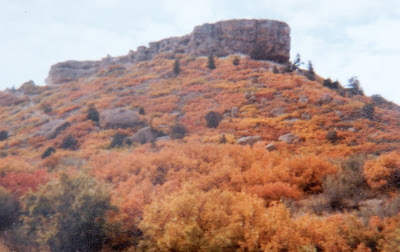 In 1984, God led me to Castle Rock, Colorado. I'm glad He led me back home a few years later.
In 1984, God led me to Castle Rock, Colorado. I'm glad He led me back home a few years later.
On my January 14 blog post, I shared that my “word of the year” is actually part of a verse from Proverbs 19. The Lord’s plans prevail. Here it is just a few weeks later and those words have totally escaped me.
As usual, I had a whole list of things I had hoped to accomplish last week. I post my goals and how I succeeded (or not) on the other blog which I maintain. (You can read about it here.) You may have guessed, whether you read that other blog or not, that I did not reach many of those goals last week.
It’s easy to mentally beat myself up over that. I really have no good reason for not doing much last week, I chose to be a couch potato and web surfer instead of being productive. But for whatever reason, maybe I wasn’t meant to get much done. Maybe it was God’s plan for me to just take the week off. Maybe (hopefully!), it is God’s plan for me to be productive next week or the week after.
I have to place my failures as well as my successes in God’s hands. He has got it covered, whatever I do or don’t do.
Thank You, Lord, for having a plan for my life, for my days. Help me to accept that it is Your will which will prevail and that all I need do is follow where You lead. Amen.
 In 1984, God led me to Castle Rock, Colorado. I'm glad He led me back home a few years later.
In 1984, God led me to Castle Rock, Colorado. I'm glad He led me back home a few years later.
Published on February 04, 2018 05:02



